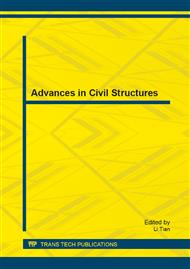p.406
p.410
p.415
p.422
p.427
p.434
p.438
p.442
p.446
Towards Light-Weight Composite Construction: Innovative Shear Connector for Composite Beams
Abstract:
Introducing low cost housing is one of the challenges face civil engineers now-days. Using lightweight construction materials i.e. cold formed steel sections is an alternate solution to overcome the challenge. In this study, a lightweight composite beam was introduced. It consists of cold formed steel section and profiled concrete slab. Experimental push tests were conducted to investigate the ductility and strength capacities of new and innovative shear connectors. The shear connectors were easy to form and give advantages to speed up the fabrication process of the proposed composite beam. The shear connectors showed large deformation and strength capacities. It is concluded that the proposed shear connectors could be used for lightweight composite beams.
Info:
Periodical:
Pages:
427-433
Citation:
Online since:
August 2013
Authors:
Price:
Сopyright:
© 2013 Trans Tech Publications Ltd. All Rights Reserved
Share:
Citation:


